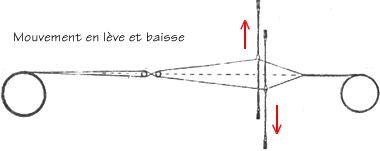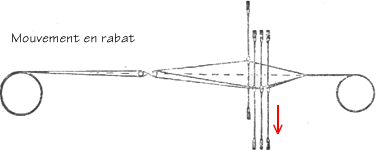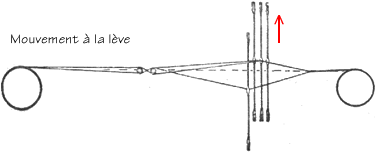- Home
- Resurrection ▾
-
Learn ▾
- Free library
- Glossary
- Documents
- Initiation
-
Shaped fabrics
- Introduction
- Popularization
- Definitions
- Le métier de façonné
- Principes du façonné
- Mécaniques de façonné
- Le jeu des crochets
- Les cartons
- Chaîne des cartons
- Mécanique 104 en détail
- Pour en finir
- Montage façonné
- Empoutage 1/3
- Empoutage 2/3
- Empoutage 3/3
- Punching, hanging and dip
- Autres façonnés
- Façonnés et Islam
-
Cours de tissage 1912
- Bâti d'un métier
- Le rouleau arrière
- Les bascules
- Formation du pas
- Position de organes
- Mécanique 104 Jacquard
- Fonctionnement 104
- Lisage des cartons
- Le battant du métier
- Le régulateur
- Réduction et régulateur
- Mise au métier d'une chaîne
- Mise en route du métier
- Navettes à soie
- Battage
- Ourdissage mécanique
- Préparation chaînes et trames
- Equipment ▾
- Chronicles ▾
- Fabrics ▾
- Techniques ▾
- Culture ▾
- Language ▾



Practical hand weaving course
Lyon Municipal Weaving SchoolProfessor A.CREPT - Year 1912-1913
The handwritten course has been copied by us.This hand weaving course on looms was used until the 1980s.

Training
In order to construct a fabric, the warp yarns must be separated into two layers sufficiently apart to allow passage of the shuttle conveying the weft. To form these two layers, ie the pitch, all the threads are passed individually for the fabrics united or armored in meshes of healds (frames) whose whole takes the name of body of remisse and when it is Necessary to form shaped fabrics they are passed in links of which the whole takes the name of bodies of links. These beams (frames) or links are controlled by special movements or by Jacquard or derivative system mechanics (Verdol, Vincenzi). The formation of the pitch (crowd) can be obtained either by raising the wires which must be above the weft, or by lowering those which must be below.
Three means are therefore used to form the step, that is to say to establish the opening of the threads in which the weft passes. The first means is given the name of movement to the rising, the second to that of downward movement (or flap), and to the third that of movement raises and falls.
These three ways of forming the step can not be used indifferently; it is necessary to choose the one which is best suited for the proper execution of the fabric to be obtained.
1 - Lifting organization
The organization is said to be raised when the threads forming the sheet which must pass over the weft is raised, while those forming the sheet which must pass under the weft remain immobile, that is to say at the bottom. This movement is generally applied to the majority of fabrics, and is usually obtained by means of different mechanical systems, which are: for the looms of ordinary fabrics, the Jacquard system (104 hooks ) Or the so-called dobbies which are of different models. For looms weaving fabrics, the Jacquard, Vincenzi or Verdol system.
2 - Organization downward or in flap
The movement is said to be downward or flap when the sheet of threads passing under the weft goes down while the sheet which is to lie on it remains stationary. The movement of the flap wires is used:- in certain kinds of plain or shaped velvet, the bottom of which is made of satin or twill, these fabrics being executed on top are more easily treated with this organization.- in some double room velvet in which it is preferable to order one of the two pieces by this means.- in certain fittings for upholstery fabrics where additional beads are to be operated as a flap.The flap movement is obtained by means of two very different devices:- by means of steps (pedals) lowering the healds, which are suspended on cavalts fixed to the loom and loaded with counterweights stronger than the weight of the heddles. The steps of the large wooden levers placed underneath the shed are called steps; each step corresponds to one or more heddles (frames) either by ropes or wires or by means of other levers known as cavalts. It follows that, by treading a step, the controlled rail goes down, and by abandoning the step, the counterweights which load the cavalts raise the lower rail to its high position, that is to say at the point of departure.The flap movement can also be obtained with ordinary mechanics working in the lift. To do this, it is enough to draw indirectly the healds, that is to say to make draw them from under, the healds being naturally suspended to coil springs or to ropes passed on pulleys and loaded with counterweights.
3 - Organization in rising and falling
With this organization the movement of the two layers of yarns is simultaneous, the yarns forming the underlying lap descend while those forming the uppermost layer rise, each of these two layers usually moves in a movement corresponding to the Half of the opening of the pitch required for the passage of the shuttle. This movement has the advantage of leaving an equal and constant tension to all the wires. The rising and falling movement is successfully used in the half-crossing plain fabrics which are generally of a difficult weaving such as for example taffetas, faults, French faults, etc. and is also used for the execution of Some shaped. Lifting and lowering organizations applied in looms weaving plain fabrics are very diverse, the one most used in Lyon is the carrette movement. In the majority of cases the organization is very simple and the organs actuating the healds producing a movement to counteract only allow to obtain the taffeta armor. In cases where it is necessary to apply a movement to the raising and lowering to form the armored fabrics in which the heddles are to be operated in a varied order, armor mechanics of 104 hooks specially constructed for this purpose are used.